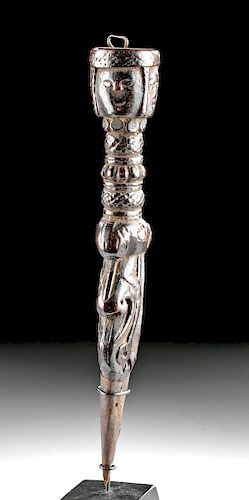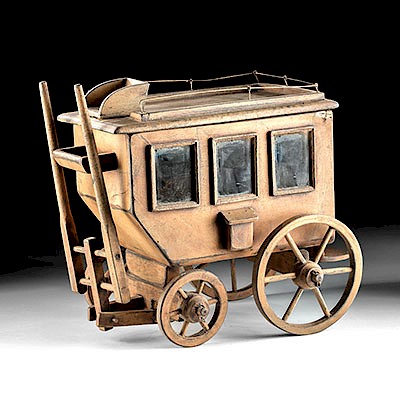19th C. Tibetan Wood & Metal Purba - Extensively Carved
Lot 200
About Seller
Artemis Fine Arts
686 S Taylor Ave, Ste 106
Louisville, CO 80027
United States
Selling antiquities, ancient and ethnographic art online since 1993, Artemis Gallery specializes in Classical Antiquities (Egyptian, Greek, Roman, Near Eastern), Asian, Pre-Columbian, African / Tribal / Oceanographic art. Our extensive inventory includes pottery, stone, metal, wood, glass and textil...Read more
Categories
Estimate:
$400 - $600
Absentee vs Live bid
Two ways to bid:
- Leave a max absentee bid and the platform will bid on your behalf up to your maximum bid during the live auction.
- Bid live during the auction and your bids will be submitted real-time to the auctioneer.
Bid Increments
| Price | Bid Increment |
|---|---|
| $0 | $25 |
| $300 | $50 |
| $1,000 | $100 |
| $2,000 | $250 |
| $5,000 | $500 |
| $10,000 | $1,000 |
| $20,000 | $2,500 |
| $50,000 | $5,000 |
| $100,000 | $10,000 |
| $200,000 | $20,000 |
About Auction
By Artemis Fine Arts
Nov 14, 2019
Set Reminder
2019-11-14 10:00:00
2019-11-14 10:00:00
America/New_York
Bidsquare
Bidsquare : Ethnographic | Tribal | American Frontier
https://www.bidsquare.com/auctions/artemis-gallery/ethnographic-tribal-american-frontier-4634
Featuring Pre-Columbian, Tribal / Oceanic, Spanish Colonial, historical examples from the Spanish, Mexican, and American frontiers, fossils, and more. All items offered for sale have been legally acquired, are legal to sell and are guaranteed to be as described or your money back. Artemis Fine Arts info@artemisfinearts.com
Featuring Pre-Columbian, Tribal / Oceanic, Spanish Colonial, historical examples from the Spanish, Mexican, and American frontiers, fossils, and more. All items offered for sale have been legally acquired, are legal to sell and are guaranteed to be as described or your money back. Artemis Fine Arts info@artemisfinearts.com
- Lot Description
Tibet, 19th century CE. An impressively carved ceremonial wooden peg known as a purba (also purpa). The three sided "blade" is extensively carved with fantastical figures and geometric motifs in relief, while the upper section presents three carved human heads. There is a small metal loop at the top and a sharp, metal covered point at the lower end. Purba is a translation for the Sanskrit term "kila" which basically refers to a peg or stake. Its function, simply put, is to hold something, like a tent, in place and stay embedded in a ritual surface or ground. An example like this, so finely carved, was likely intended to be a ritual object, perhaps used during the creation of special mandalas or a consecration ritual. Size: 9.5" H (24.1 cm); 11" H (27.9 cm) on included custom stand.
A purba is a ritual object according to early Indian tantric writings. However, a purba is also the name for a beloved Tibetan tantric deity (Dorje Purba, Vajrakila) stemming from the Nyingma tradition of Tibetan Buddhism. This deity traditionally presents three faces, wings, six hands, a consort, and a lower body in the form of a purba rather than legs. Perhaps the three faces at the top of this purba were intended to represent this deity.
Provenance: Tambaran Gallery, New York, New York, USA
All items legal to buy/sell under U.S. Statute covering cultural patrimony Code 2600, CHAPTER 14, and are guaranteed to be as described or your money back.
A Certificate of Authenticity will accompany all winning bids.
We ship worldwide and handle all shipping in-house for your convenience.
#149112Carving is very well preserved and vivid. Metal loop atop the purba shows some bending. Indentations to and nail missing from lower metal sheet covered point. Both metal loop and metal sheet covering the point have developed nice age patina.Condition
- Shipping Info
-
All shipping is handled in-house for your convenience. Your invoice from Artemis Gallery will include shipping calculation instructions. If in doubt, please inquire BEFORE bidding for estimated shipping costs for individual items.
-
- Buyer's Premium



 EUR
EUR CAD
CAD AUD
AUD GBP
GBP MXN
MXN HKD
HKD CNY
CNY MYR
MYR SEK
SEK SGD
SGD CHF
CHF THB
THB














